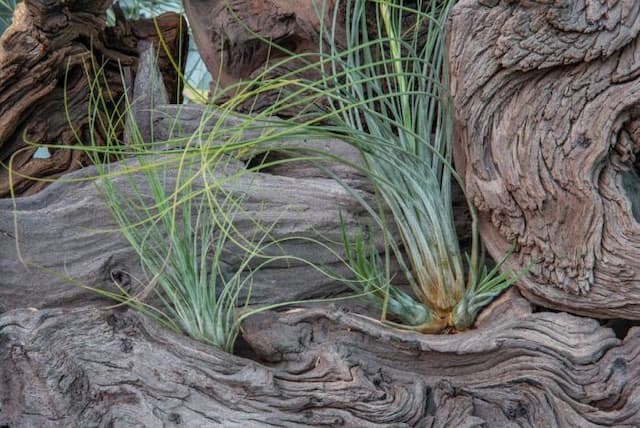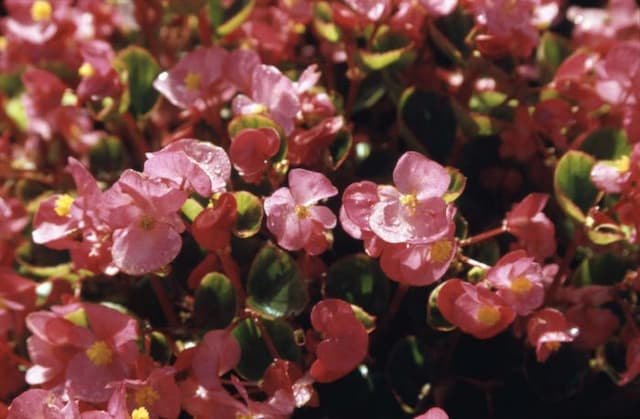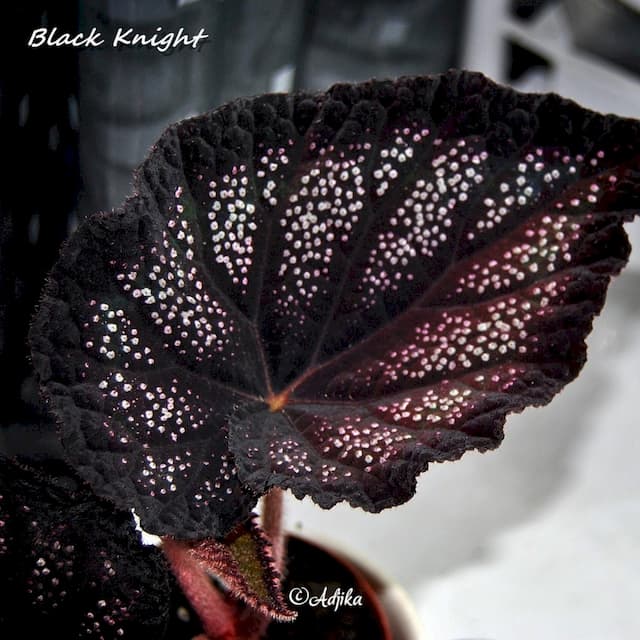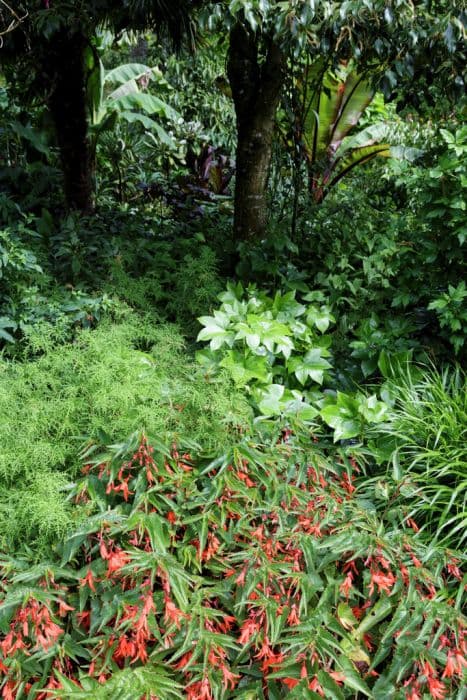Inca Fire Begonia Begonia 'Inca Fire' PBR (R)

ABOUT
Begonia 'Inca Fire' PBR (R) is a vibrant and striking plant, renowned for its intense coloration and lush appearance. The plant features bold, asymmetrical leaves that are a rich, dark green on top but surprise with a fiery red underside, giving it a unique and dramatic look, especially when the leaves catch the breeze and reveal their stunning contrasting colors. The foliage often displays a speckled or marbled pattern of lighter green or silvery-white, creating a textured and visually interesting effect. Throughout the blooming season, the Begonia 'Inca Fire' produces abundant clusters of flowers. The flowers are small yet showy, radiating in warm hues ranging from deep orange to red, reminiscent of glowing embers or a blazing sunset. These blossoms add another layer of appeal to the plant, attracting both the eyes of admirers and the attention of pollinators like butterflies and hummingbirds. The overall presentation of Begonia 'Inca Fire' is one of lushness and vitality, making it a popular choice among gardeners and plant enthusiasts who seek to add a touch of exotic flair to their indoor or outdoor spaces.
About this plant
 Names
NamesSynonyms
Inca Fire Begonia
Common names
Begonia 'Inca Fire' PBR
 Toxicity
ToxicityTo humans
Begonias, generally, can be mildly toxic if ingested. The toxicity is mainly due to compounds known as oxalates, which can cause irritation of the mouth, lips, throat, and tongue. If a person chews or ingests parts of the Begonia, they may experience symptoms such as burning sensations in the affected area, swollen lips or tongue, and difficulty swallowing. In severe cases, gastrointestinal irritation like nausea, vomiting, or diarrhea can occur. It's important to avoid ingesting any part of the plant and to keep it away from small children who might chew on the leaves or flowers.
To pets
Begonias are considered mildly toxic to pets due to the same oxalate crystals found in the plant's tissues. If a pet, such as a dog or cat, ingests part of a Begonia, they could experience symptoms such as oral irritation, drooling, vomiting, and difficulty swallowing. Pets might also paw at their face due to the discomfort. It's advisable to keep Begonias out of reach of pets and to contact a veterinarian if you suspect your pet has ingested any part of the plant.
 Characteristics
CharacteristicsLife cycle
Perennials
Foliage type
Evergreen
Color of leaves
Variegated
Flower color
Red
Height
1 foot 2-3 inches (35-40 cm)
Spread
1 foot 2-3 inches (35-40 cm)
Plant type
Herb
Hardiness zones
10
Native area
South America
Benefits
 General Benefits
General Benefits- Attractive Foliage: Begonia 'Inca Fire' PBR features striking leaves with warm tones that can add a splash of color to any garden or pot.
- Long Flowering Season: This plant typically blooms for an extended period, providing vibrant color from late spring to early autumn.
- Low Maintenance: As a hardy variety, it requires minimal care, making it suitable for both novice and experienced gardeners.
- Drought Tolerant: Once established, Begonia 'Inca Fire' can withstand periods of dryness, making it ideal for water-wise gardens.
- Versatile Planting Options: It can be planted in garden beds, containers, or hanging baskets, providing flexibility in garden design.
- Non-Invasive: This Begonia is not known to be invasive, so it can safely be incorporated into various garden settings without concern for overtaking other plants.
- Pest Resistance: It often exhibits resistance to common garden pests, reducing the need for chemical treatments.
- Deer Resistance: The plant is less likely to be eaten by deer, which can be particularly beneficial in areas where deer predation is a problem.
 Medical Properties
Medical PropertiesThis plant is not used for medical purposes.
 Air-purifying Qualities
Air-purifying QualitiesThis plant is not specifically known for air purifying qualities.
 Other Uses
Other Uses- Natural Dye: The vibrant flowers of Begonia can be used to produce natural dyes for fabric, offering a range of hues from pinks to oranges depending on the mordant used.
- Crafts: Pressed Begonia flowers can be used to create beautiful bookmarks, greeting cards, or to embellish picture frames, adding natural beauty to various craft projects.
- Photography: With its striking appearance, Begonia 'Inca Fire' serves as an excellent subject for botanical photography, aiding in the exploration of plant form and color dynamics.
- Teaching Aid: This plant can be used as an educational tool to teach children or gardening enthusiasts about plant care, propagation, and the lifecycle of flowering plants.
- Art Inspiration: Artists can use the intricate patterns and colors of Begonia 'Inca Fire' as inspiration for paintings, drawings, or textile designs.
- Culinary Decoration: Although not a common use, the petals of certain begonia species are edible and can be used as a colorful garnish for salads and desserts (only if confirmed that this particular variety is safe to eat).
- Garden Design: Can be used in themed gardens, like a 'fire' themed area, to represent the element of fire through its fiery colors and foliage.
- Eco-Friendly Confetti: Dried petals of the Begonia 'Inca Fire' can be used as biodegradable confetti for outdoor celebrations, reducing environmental impact.
- Floral Arrangements: The bold colors and shapes of Begonia 'Inca Fire' can be added to floral arrangements to provide extraordinary contrast and visual interest.
- Psychology Studies: Due to its stimulating colors, researchers in environmental psychology might use Begonia 'Inca Fire' as a stimulus in studies exploring human reactions to color and natural beauty.
Interesting Facts
 Feng Shui
Feng ShuiThe Begonia is not used in Feng Shui practice.
 Zodiac Sign Compitability
Zodiac Sign CompitabilityThe Begonia is not used in astrology practice.
 Plant Symbolism
Plant Symbolism- Caution: The begonia often represents a warning or a sense of caution, as in traditional Victorian symbolism, a gift of begonia was a sign to 'be wary'.
- Unique Beauty: Known for its distinct and vibrant flowers, the begonia symbolizes uniqueness and a stand-out beauty that grabs attention.
- Harmony: The balanced growth and temperament of begonias under the right conditions represent harmony and a peaceful environment.
- Gratitude: Begonias can be given as a sign of thanks or appreciation, symbolizing deep gratitude and respect for another person.
- Individuality: The plant's varied leaf patterns and colors highlight personal uniqueness, representing the celebrating of one's individuality.
 Water
WaterThe fiery Begonia, also known as Begonia 'Inca Fire', requires consistent moisture but doesn't like to sit in water. Water it when the top inch of soil feels dry to the touch, which might be about once a week, depending on the environment. When watering, gently pour water at the base of the plant until it begins to run out of the bottom of the pot, ensuring the roots are getting enough moisture. Use room temperature water to avoid shocking the plant. During the active growing season in spring and summer, you might need up to 16 ounces of water per week, but always test soil moisture before watering to prevent over-saturation.
 Light
LightBegonia 'Inca Fire' thrives best in bright, indirect light. An ideal spot would be near a window that receives plenty of light but is shielded from the harsh midday sun. East or west-facing windows are often perfect for providing the gentle morning or afternoon light that this plant prefers.
 Temperature
TemperatureThe fiery Begonia (Begonia 'Inca Fire') prefers warm conditions and performs best at temperatures between 60°F and 75°F. It should not be exposed to temperatures below 50°F, as cold can damage the plant. In terms of maximum temperature, avoid placing it where the temperature exceeds 86°F as this may stress the plant.
 Pruning
PruningPruning the fiery Begonia promotes bushier growth and removes any dead or yellowing leaves, helping to keep the plant healthy and attractive. Prune as needed throughout the year, and for shaping or size control, the best time to prune is in the spring. Always use clean, sharp scissors or pruners to make clean cuts.
 Cleaning
CleaningAs needed
 Soil
SoilBegonias such as 'Inca Fire' prefer a well-draining, rich potting mix with peat, perlite, and compost. Ideal soil pH is slightly acidic to neutral, ranging from 5.5 to 7.
 Repotting
Repotting'Inca Fire' Begonias should be repotted every 1-2 years to replenish soil nutrients and accommodate root growth.
 Humidity & Misting
Humidity & Misting'Inca Fire' Begonias thrive in moderate to high humidity, ideally between 50-70%.
 Suitable locations
Suitable locationsIndoor
Place 'Inca Fire' Begonia in bright, indirect light indoors.
Outdoor
Grow 'Inca Fire' Begonia in shaded area with morning sun.
Hardiness zone
10-11 USDA
 Life cycle
Life cycleThe Begonia 'Inca Fire', also known simply as Inca Fire Begonia, begins its life as a seed, which, when exposed to the right conditions of warmth and moisture, will germinate and sprout. The next stage is the seedling phase, during which the plant develops its first true set of leaves. Following this, the begonia enters a period of vegetative growth, characterized by the expansion of foliage and root system, preparing the plant for flowering. Eventually, it reaches the flowering stage, producing vibrant red-orange blooms that attract pollinators and can last throughout the warm season. Post-pollination, the plant may produce seeds, which heralds the start of the next generation. Finally, as a perennial, it may enter a dormancy phase in response to cooler temperatures, where growth slows down until conditions become favorable again.
 Propogation
PropogationPropogation time
Spring-Early Summer
The Begonia 'Inca Fire' is frequently propagated through stem cuttings, which is considered the most popular method for this plant due to its simplicity and effectiveness. This technique is best carried out in late spring to early summer, when the plant is actively growing and can recover quickly. To propagate from stem cuttings, a sharp, clean knife or pair of scissors is used to take a 3 to 4-inch (approximately 7.5-10 cm) cutting from a healthy, non-flowering stem. The cutting should have at least one node, which is where the leaves or buds grow from, as this is where roots will form. The cutting end is then dipped in rooting hormone powder to encourage root growth and planted in a well-draining soil mix. It should be kept moist but not waterlogged, and placed in a warm spot with indirect sunlight. Roots typically develop within a few weeks, after which the new plant can eventually be transplanted into its own pot.

![Begonia [Allure]](/_next/image?url=https%3A%2F%2Fplants-admin.emdemapps.com%2Fimages%2Fplants%2F%2Fimages%2F604b5b9006ab9.png&w=640&q=75)







